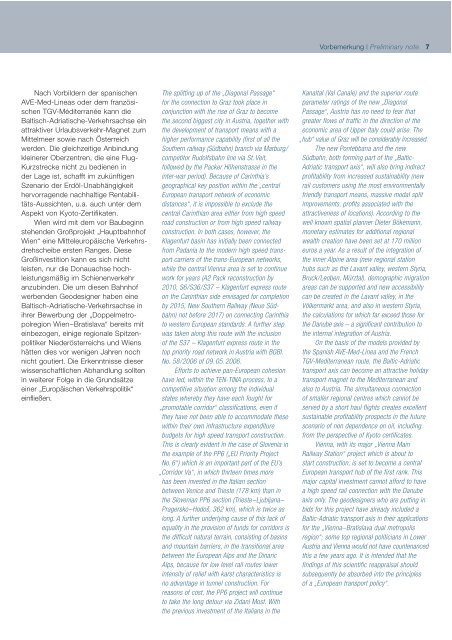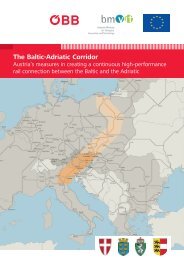Inhalt | Contens - baltic-adriatic.eu
Inhalt | Contens - baltic-adriatic.eu
Inhalt | Contens - baltic-adriatic.eu
Sie wollen auch ein ePaper? Erhöhen Sie die Reichweite Ihrer Titel.
YUMPU macht aus Druck-PDFs automatisch weboptimierte ePaper, die Google liebt.
Nach Vorbildern der spanischen<br />
AVE-Med-Lineas oder dem französischen<br />
TGV-Méditerranée kann die<br />
Baltisch-Adriatische-Verkehrsachse ein<br />
attraktiver Urlaubsverkehr-Magnet zum<br />
Mittelmeer sowie nach Österreich<br />
werden. Die gleichzeitige Anbindung<br />
kleinerer Oberzentren, die eine Flug-<br />
Kurzstrecke nicht zu bedienen in<br />
der Lage ist, schafft im zukünftigen<br />
Szenario der Erdöl-Unabhängigkeit<br />
hervorragende nachhaltige Rentabilitäts-Aussichten,<br />
u.a. auch unter dem<br />
Aspekt von Kyoto-Zertifikaten.<br />
Wien wird mit dem vor Baubeginn<br />
stehenden Großprojekt „Hauptbahnhof<br />
Wien“ eine Mittel<strong>eu</strong>ropäische Verkehrsdrehscheibe<br />
ersten Ranges. Diese<br />
Großinvestition kann es sich nicht<br />
leisten, nur die Donauachse hochleistungsmäßig<br />
im Schienenverkehr<br />
anzubinden. Die um diesen Bahnhof<br />
werbenden Geodesigner haben eine<br />
Baltisch-Adriatische-Verkehrsachse in<br />
ihrer Bewerbung der „Doppelmetropolregion<br />
Wien–Bratislava“ bereits mit<br />
einbezogen, einige regionale Spitzenpolitiker<br />
Niederösterreichs und Wiens<br />
hätten dies vor wenigen Jahren noch<br />
nicht goutiert. Die Erkenntnisse dieser<br />
wissenschaftlichen Abhandlung sollten<br />
in weiterer Folge in die Grundsätze<br />
einer „Europäischen Verkehrspolitik“<br />
einfließen.<br />
The splitting up of the „Diagonal Passage“<br />
for the connection to Graz took place in<br />
conjunction with the rise of Graz to become<br />
the second biggest city in Austria, together with<br />
the development of transport means with a<br />
higher performance capability (first of all the<br />
Southern railway (Südbahn) branch via Marburg/<br />
competitor Rudolfsbahn line via St. Veit,<br />
followed by the Packer Höhenstrasse in the<br />
inter-war period). Because of Carinthia’s<br />
geographical key position within the „central<br />
European transport network of economic<br />
distances“, it is impossible to exclude the<br />
central Carinthian area either from high speed<br />
road construction or from high speed railway<br />
construction. In both cases, however, the<br />
Klagenfurt basin has initially been connected<br />
from Padania to the modern high speed transport<br />
carriers of the trans-European networks,<br />
while the central Vienna area is set to continue<br />
work for years (A2 Pack reconstruction by<br />
2010, S6/S36/S37 – Klagenfurt express route<br />
on the Carinthian side envisaged for completion<br />
by 2015, New Southern Railway (N<strong>eu</strong>e Südbahn)<br />
not before 2017) on connecting Carinthia<br />
to western European standards. A further step<br />
was taken along this route with the inclusion<br />
of the S37 – Klagenfurt express route in the<br />
top priority road network in Austria with BGBl.<br />
No. 58/2006 of 09. 05. 2006.<br />
Efforts to achieve pan-European cohesion<br />
have led, within the TEN-TINA process, to a<br />
competitive situation among the individual<br />
states whereby they have each fought for<br />
„promotable corridor“ classifications, even if<br />
they have not been able to accommodate these<br />
within their own infrastructure expenditure<br />
budgets for high speed transport construction.<br />
This is clearly evident in the case of Slovenia in<br />
the example of the PP6 („EU Priority Project<br />
No. 6“) which is an important part of the EU’s<br />
„Corridor Va“, in which thirteen times more<br />
has been invested in the Italian section<br />
between Venice and Trieste (178 km) than in<br />
the Slovenian PP6 section (Trieste–Ljubljana–<br />
Pragersko–Hodosˇ, 362 km), which is twice as<br />
long. A further underlying cause of this lack of<br />
equality in the provision of funds for corridors is<br />
the difficult natural terrain, consisting of basins<br />
and mountain barriers, in the transitional area<br />
between the European Alps and the Dinaric<br />
Alps, because for low level rail routes lower<br />
intensity of relief with karst characteristics is<br />
no advantage in tunnel construction. For<br />
reasons of cost, the PP6 project will continue<br />
to take the long detour via Zidani Most. With<br />
the previous investment of the Italians in the<br />
Vorbemerkung | Preliminary note 7<br />
Kanaltal (Val Canale) and the superior route<br />
parameter ratings of the new „Diagonal<br />
Passage“, Austria has no need to fear that<br />
greater flows of traffic in the direction of the<br />
economic area of Upper Italy could arise. The<br />
„hub“ value of Graz will be considerably increased.<br />
The new Pontebbana and the new<br />
Südbahn, both forming part of the „Baltic-<br />
Adriatic transport axis“, will also bring indirect<br />
profitability from increased sustainability (new<br />
rail customers using the most environmentally<br />
friendly transport means, massive modal split<br />
improvements, profits associated with the<br />
attractiveness of locations). According to the<br />
well known spatial planner Dieter Bökemann,<br />
monetary estimates for additional regional<br />
wealth creation have been set at 170 million<br />
<strong>eu</strong>ros a year. As a result of the integration of<br />
the inner Alpine area (new regional station<br />
hubs such as the Lavant valley, western Styria,<br />
Bruck/Leoben, Mürztal), demographic migration<br />
areas can be supported and new accessibility<br />
can be created in the Lavant valley, in the<br />
Völkermarkt area, and also in western Styria,<br />
the calculations for which far exceed those for<br />
the Danube axis – a significant contribution to<br />
the internal integration of Austria.<br />
On the basis of the models provided by<br />
the Spanish AVE-Med-Linea and the French<br />
TGV-Mediterranean route, the Baltic-Adriatic<br />
transport axis can become an attractive holiday<br />
transport magnet to the Mediterranean and<br />
also to Austria. The simultaneous connection<br />
of smaller regional centres which cannot be<br />
served by a short haul flights creates excellent<br />
sustainable profitability prospects in the future<br />
scenario of non dependence on oil, including<br />
from the perspective of Kyoto certificates.<br />
Vienna, with its major „Vienna Main<br />
Railway Station“ project which is about to<br />
start construction, is set to become a central<br />
European transport hub of the first rank. This<br />
major capital investment cannot afford to have<br />
a high speed rail connection with the Danube<br />
axis only. The geodesigners who are putting in<br />
bids for this project have already included a<br />
Baltic-Adriatic transport axis in their applications<br />
for the „Vienna–Bratislava dual metropolis<br />
region“; some top regional politicians in Lower<br />
Austria and Vienna would not have countenanced<br />
this a few years ago. It is intended that the<br />
findings of this scientific reappraisal should<br />
subsequently be absorbed into the principles<br />
of a „European transport policy“.



